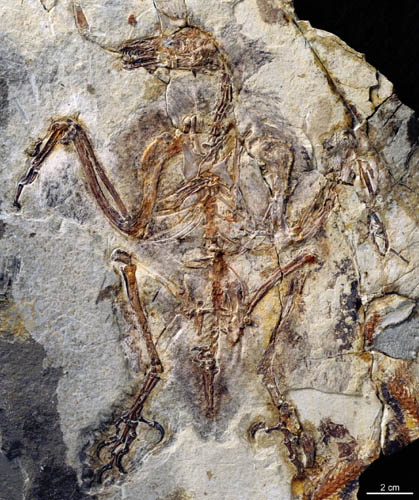New Enantiornithine Bird With Ornamented Tooth Enamel Found From Liaoning, China
The new specimen is a slab containing a nearly complete adult or subadult individual, generally preserved in ventral view, with poorly preserved feathers around the skull and shoulders. It was found from the Early Cretaceous of Yixian Formation near Lamadong Village, Jianchang County, Huludao City, Liaoning Province, China.
The genus name comes from the Latin words "sulcus" (groove) and "avis" (bird), reflecting the unusual dental characteristics of the genus. The species name is to honour the Gee family from La Ca?ada (US) "because of their generous contributions to the research of Mesozoic birds".
Sulcavis geeorum is closely related to the recently described Shenqiornis mengi, with which it shares aspects of the dental morphology. Researchers included the two taxa in a phylogenetic analysis to explore this potential relationship, and they found that Sulcavis geeorum has distinct morphologies in the skull and postcranial skeleton that suggest that it represents a new taxon.
Approximately half of all enantiornithines are known from the Jehol Group in the world, unfortunately, not one published specimen preserves direct evidence of trophic habit such as stomach contents, although numerous ornithuromorph specimens preserve ingested remains and other indicators of diet. To date, the only way to infer the trophic habit of enantiornithines from the Jehol Group is through their cranial or dental morphology.
"Enantiornithines exhibit a wide range of cranial morphologies and the long rostrum of some of these taxa has been used to infer specific trophic specializations. A diversity of dental shapes, sizes, and patterns are also apparent in the Jehol enantiornithines. However, although the teeth range in overall morphology, caudal curvature, lateral compression, and size, no previous specimens have preserved ridges, striations, denticles, or any other form of dental ornamentation", said study coauthor Dr. ZHANG Yuguang, Beijing Museum of Natural History.
"The enantiornithines are unique among birds in showing minimal tooth reduction and a diversity of dental patterns. This new enantiornithine has robust teeth with grooves on the inside surface, which likely strengthened the teeth against harder food items. It mostly had a durophagous diet. Compared with other Mesozoic groups, stomach contents are hardly ever preserved within enantiornithine specimens; therefore, this new tooth morphology not only increases the known diversity of tooth shape in early birds, but also reveals new evidence regarding the diversity of trophic niches occupied by the early primitive birds”, said study lead author Dr. Jingmai K. O'Connor of the IVPP.

Fig.1 Photograph of the holotype of Sulcavis geeorum. (Image by Jingmai K. O'Connor)

Fig.2 Details of the right premaxillary-maxillary teeth of Sulcavis geeorum in lingual view. A, photograph of the dentition at the right premaxilla-maxilla contact; B, close up of maxillary tooth; C, interpretative drawing of maxillary tooth. (Image by Jingmai K. O'Connor)
Download attachments: